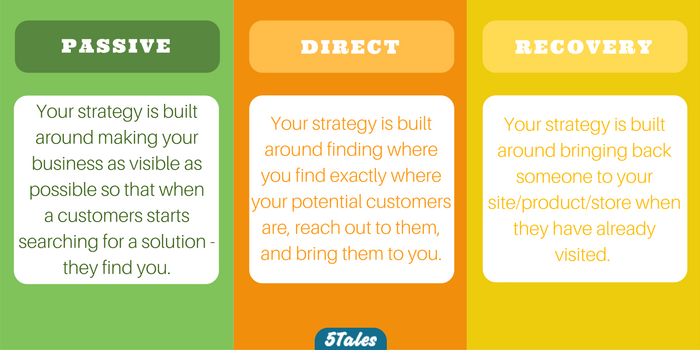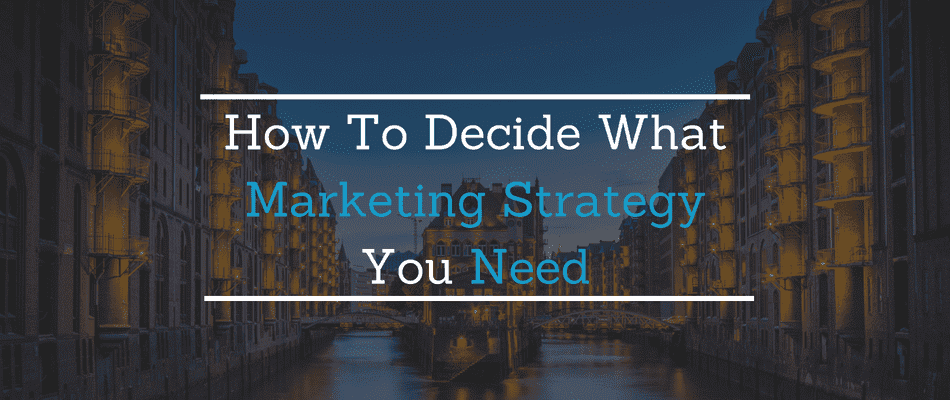Digital marketing is an absolute must for businesses in today’s marketplace, and yet there are so many choices to be made that it can overwhelm even the biggest companies, let alone the savvy small business owner. With SEO, PPC and Social Media being the terms constantly thrown in the face of companies – it can be really hard to discover what’s what.
We believe that there is no reason for a marketing firm to spend their time confusing customers with terms that only they understand (“Ever heard our Screaming Frog SEO tool that allows us to optimise URL architecture of your PPLs?” What?!!).
That’s why we decided to collate all of the strategies for you, and breakdown how and when to use each of them.
Forms of Digital Marketing
Now before we can analyse the platforms or strategies for getting leads it makes more sense to take a look at the categories that these platforms fit in;

Passive – Passive digital marketing refers to a strategy where instead of trying to find your customers and bring them to your site or product or store – your strategy is built around making your business as visible as possible so that when a customer’s wants to find you, they can! These campaigns are usually far longer term than the other two.
Direct – Direct digital marketing refers to strategies where you find exactly where your customers are, reach out to them, and bring them to you. It is far more intrusive than a passive campaign but is usually able to achieve much faster results.
Recovery – Recovery campaigns are generally run concurrently with passive and direct marketing. It refers to bringing back someone to your site, product or store when they have already shown interest or have actually visited. These campaigns do not bring more people to your site, instead it turn’s previous ‘window shoppers’ into sales.
[cta id=”2091″ vid=”0″]
So Which Digital Marketing Strategy Should You Choose?
Those are the three general categories your marketing could fall into. Something to keep in mind though, is that you wouldn’t start your marketing with a Recovery campaign. That means that when you get started, you are probably looking at whether you want to start with Passive, Direct or both.
To choose between the two, the biggest differentiator is time. Passive campaigns are longer term and generally take longer to receive results. Direct campaigns have almost immediate impacts, but require far more maintenance. Different businesses need results in different time frames. Let’s use two different business examples:
Example 1: The busy season for your 1 year old lawn mowing company might be just about to start and so lead generation needs to be at the forefront of your mind. You have very few existing or prior customers to connect with, and so finding potential customers is hard. A Direct marketing campaign has to be the first thing you do. It will generate a lot of leads, and requires almost no existing infrastructure.
Example 2: Your lawn mowing company is 8 years old. Your existing and previous customer base is extremely substantial. Right now, your resources are almost totally tapped out and any new leads would be unmanageable. Instead of needing leads now, you want to build a sustainable lead building infrastructure moving forward over the next year and onwards. This is where Passive marketing will come into play.
Those are pretty cut and dry examples, but the idea of immediate versus sustainable is one smart businesses are thinking about. That said, there are a lot of businesses who have to think about both and it is just as sustainable as doing one.
So What Are The Actual Platforms?
Knowing the general concept of a strategy is worth nothing, if you aren’t able to then go ahead and start actioning the strategy properly. To make it easier once you know what strategies you are interested in targeting here are some, but not all of the platforms to then do that on.

Search Engine Optimization (SEO)
SEO is the process of ranking a website in Search Engine Results (think Google results) for specific terms (these terms are known as keywords). This refers to both on-page SEO (what’s on your website) and off-page SEO (other things on the web pointing to your website).
It can take anywhere from a 2-3 months to 18-24 months for you to see significant results. The success of these campaigns comes down generally to the niche or market you operate in, how much work has previously been done on your website and the quality of your strategy.
Organic Social Media
Social Media Marketing is extremely broad, but this is one of the main ‘buckets’ it can fall into. Organic social media is essentially the general content you put onto your social platforms, as well as how you grow your reach on those platforms.
It is also quite a long term play and one which requires constant attention, and differs significantly based upon what social network/s you focus on.
Content Marketing
Content Marketing generally refers to content in the form of articles, videos and images that you post to your websites blog, an external blog (eg. Medium) or a media sharing site (eg. Youtube). The term also includes any promotion of that content, and growth strategies like guest blogging.
It can take quite some time to build up a library of content and gain a foothold on your ideal audience, but pays significant dividends.

Google AdWords
Google AdWords is the short term version of SEO. Instead of slowly ranking at the top spot for a keyword, AdWords allows you to pay for a spot about the organic search results. There are between 2-4 of these results per page and you pay on a per click basis.
You can start Google AdWords today and begin having ads appear, but as it is a battle of small improvements, you will need to check the performance on a regular basis. Depending upon your interest and the size of the campaign, this could be daily, weekly or even monthly.
You can spend a lot of $$$’s on adwords very quickly, with little to show for it, if you are not careful. If you are tackling it yourself, be sure to take advantage of the assistance which Google provides in terms of phone support.
Social Media Advertising
This is the second bucket of Social Media Marketing. Instead of creating content to organically appear in the feeds of potential customers, this involves paying for ads to appear. Results will vary quite significantly from platform to platform, and even from ad to ad.Facebook for instance has Newsfeed ads but also allows you to pay for sidebar ads.
Yet again, you could start today, but it will again take some time to tweak and adjust. The other contributing factor is usually these platforms require visual content not just the text of AdWords or general visuals of a display campaign.
Influencer Marketing
Influencer Marketing is the final Social Media bucket. This involves getting influencers (accounts with followers of a large number or who would be interested in you) and getting them to promote your content or mention your brand. This can be paid, or sometimes can be rewarded solely through some kind of promotion.
Finding influencers who are useful for you and who are interested can take some time, but the effects of the campaign after launch will be immediate. So while this is a good strategy when money is tight, the time investment to find valuable partners is substantial.
Email Marketing
Email Marketing follows a different tact to the other channels on this list. It is generally far more personal and is very targeted, due solely to the way email works. Even though people’s inboxes have become flooded in recent years – this tactic still works a treat. Even better still, is the low cost of entry.
If you are only emailing people whose emails you gathered through a blog, landing page or even just a form on your website – the cost is near nothing. Cold Email on the other hand, can have some cost in acquiring the emails you need.
The timeframe for email marketing can vary. This depends on if you try and sell in your first email to someone, or whether you choose to perform a drip campaign. That said it is generally between an hour to two days where you will receive results from your sales email.

Retargeting Campaign
Retargeting is an easy way to try and recover traffic that might have reached your homepage or another specified page on your site. What happens is that by installing a tracking code onto your website, you can run an advertising campaign that will target those visitors again. This can be setup to run on Facebook, through Google Ads as well as many more.
The effects of a retargeting campaign are almost immediate, but it’s value will only really come into play as the level of traffic increases. Greater volume will always increase performance.
Cart/Product Abandonment Email Campaign
Earlier we mentioned the value of email marketing as a direct marketing platform, but as a form of recovery it is one of the best. This is a common tactic for ecommerce and online retail sites When a visitor reaches their cart page and leaves or views a product and leaves – you can track that. You can then send them follow up emails reminding them to purchase their product or fulfill their order.
These campaigns will vary greatly in success, depending upon what kind of copy you use in the emails, but once it is setup – results should be immediate.
Decision Time
Making the choice on what strategy and tactic to go after is one that shouldn’t hold up progress for too long. Getting started on a campaign early will allow you to test and improve your process to maximise results. The worst decision you can make – is no decision.
Although certain campaigns would be more or less effective based on business type – not choosing any will set you back further than making the wrong decision. It comes to how much your are able to manage to learn yourself or afford to hire a specialist to do for you.
Ultimately, almost all of these campaigns have the potential to make a major impact on your business, regardless of industry.
[cta id=”2091″ vid=”0″]
